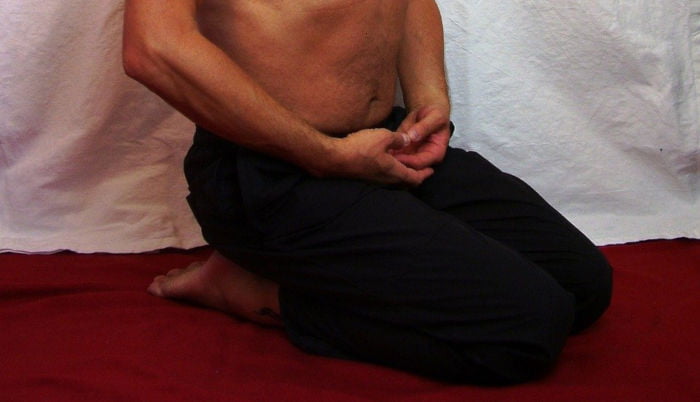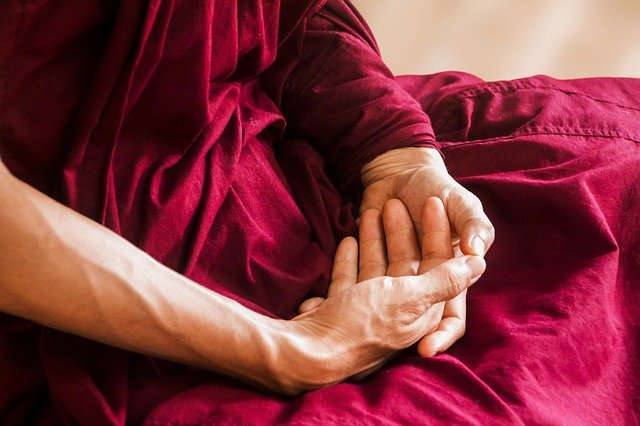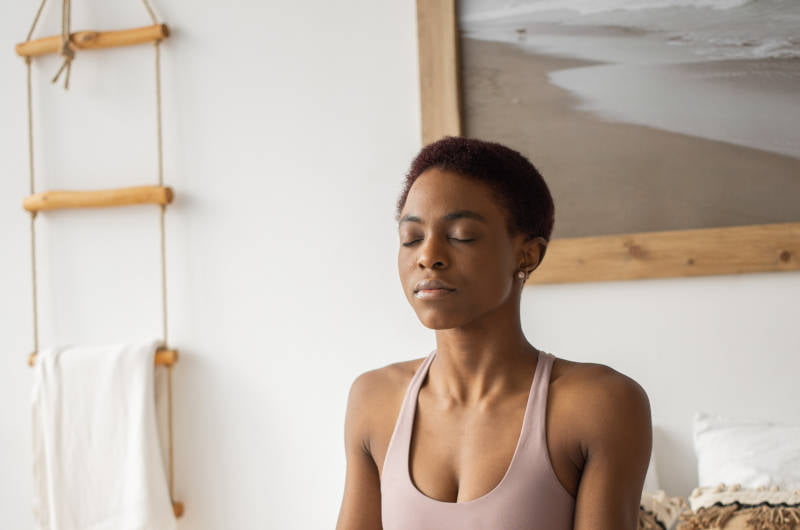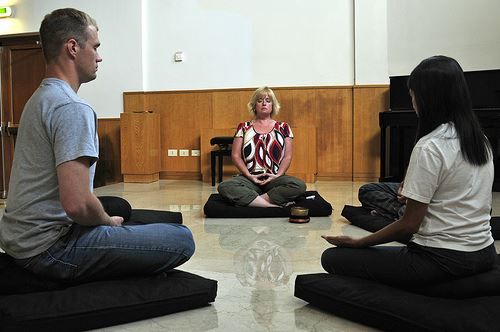You’re going to learn how to do Zazen meditation. Zazen is the main meditation technique practiced in Zen Buddhism. It’s essentially a mindfulness meditation that emphasizes harmonizing the body, mind and breath.
The Zazen instructions are below. In the video, it’s a guided meditation.
You can follow along with the video. You can also just scroll down and read along with my voice.
Either way, you will learn Zen meditation with the proper visuals.
Or just hit the play button…
…listen …
… and enjoy!
There is More Than 1 Way to Do Zazen
Zen has so many different lineages, so there are tons of variations of Zen techniques. However, Zazen does have a few central principles that seem to exist in every variant.
Zazen Posture

Posture is very important in Zazen meditation. Zen places a big emphasis on building a physical foundation for meditation.
The traditional sitting postures are the half lotus and the full lotus. For most people, I would not recommend either. There are other, semi-traditional postures as well.
The most important thing to remember about Zazen posture is that you keep your back straight.
If you use a cushion, you can sit cross legged in normal sitting meditation style. Try to make sure your knees are lower than your butt.
I’m sitting in a plastic lawn chair. If you’re doing this in a chair, put both feet flat on the floor and do not lean back on the chair.
In some lineages, they stand with feet about a shoulder width apart with the toes pointing slightly outward.
Some practitioners kneel while sitting on their heels/ankles.
Regardless of your posture, you want your tailbone planted firmly. Starting with your tailbone, stack all vertebrae one on top of another. Work your way all the way up. Tuck in your chin just a little bit. Your crown should feel like it’s holding up the sky.
Tongue Position
Close your mouth and teeth. Don’t clench tightly. Just relax your mouth.
Point your tongue upward toward the roof of the mouth. Push it back toward the throat. Give it a good swallow to signal your body not to produce saliva.
Hand Mudra (Position)

Face your right palm upward with the four fingers together. Bring it to the point just below the navel. Point your fingers to the left.
Do the same with your left hand, but point your fingers to the right. Place your left hand fingers on top of your right hand fingers.
The point of the middle knuckle of the left index finger is resting in the groove of the middle knuckle of the right index finger.
The point of the middle knuckle of the left middle finger is resting in the groove of the middle knuckle of the right index finger.
And so on. This is approximate.
Rest hands on your lap in this position. The pinkies are resting on your lap, and your thumbs still don’t know what the hell they’re doing.
In this position, your thumbs kind of want to meet each other. Gently press the thumbs together, forming the best circle you can. The “hole” should have some roundness and integrity to it. It’s a firm circle.
Just relax the hands in this mudra with your lap supporting the pinkies. Nothing is forced. Relax your shoulder muscles and just let gravity hold the hands in place.
Zazen Gaze

In traditional Zazen meditation, your eyes are open. However, many experienced practitioners and teachers just keep it simple and close their eyes completely.
If you want to do it old school, here are the instructions:
Focus on a point about three feet in front of you. Your eyes may want to close slightly. Now look down at a 45 degree angle toward the ground. Don’t move your head to do this. Remember you’re keeping your spine straight.
Your eyes are not open too much and not closed too much. You’re focusing on nothing in particular.
How to Do Zazen

First, check your posture. Move your upper body from side to side. Find the sweet spot so that your back feels straight. Let your shoulders and arms relax instead of fighting gravity.
Breathe through the nose. Allow your chest to relax so that your abdomen is what is moving. It is like your abdomen is filling like a balloon. There is pressure in all directions on the inhale, including toward the back.
Your focus point is the hara, the point that is a couple finger widths below the navel and just a little bit toward the inside of the body.
The breath should be nice and easy. Imagine that the hara is pulling or drawing the breath into itself. It’s doing all the work in your breathing.
Focus on the breath with particular attention on the hara. This is what you are “falling in love” with. As you become more absorbed in this, your breath may become longer and deeper.
If it helps you any, you can make the exhale longer than the inhale so that all breath is pushed out. This will make the inhale very natural.
ADDING IN SOME MINDFULNESS
Here’s the mindfulness part. Thoughts, emotions and other processes may try to take you away from Zazen. The only way they can take you away from Zazen is if you get caught up in your thoughts and follow them.
Don’t do that. Let your thoughts be. Thoughts come and go. Don’t engage them. Just allow them to be part of your meditation. You are the impartial observer. They arise and fall like waves on the ocean.
Gently and easily come back to your posture, your hara and your breath. Is your spine still straight? How’s the circle you’re making with your thumbs?
The hara and the breath are all that exist. If you get distracted again, let the thoughts and emotions arise and fall again. Then, come back to the hara, breath and posture.
Grounding Zen Meditation Into Daily Life
That was Zazen meditation, the primary Zen meditation technique. For best results, you want to practice consistently. That means every day, even if you only have five minutes to do it. Consistency is most important because it rewards you with a momentum of peace, awareness and equanimity.
The other major Zen technique is designed to anchor this meditative awareness into daily life. Monks practice it in between Zazen sessions. This practice is Zen Walking Meditation.
Share Your Insights or Questions
What are your experiences with Zen meditation techniques? Share them in a comment below.
Is anything unclear/wrong/etc? Ask a question or chime in with some input below.
Tom Von Deck is a meditation trainer, speaker, and speaker. Tom specializes in making meditation much much easier for busy and non-busy people from all backgrounds and paths. He is the Mackdaddy of The Deeper Meditation Video Zone and DeeperMeditation.net.



3 comments
B Meditation Studio
Only wanna remark on few general things, The website design is perfect, the content material is rattling good. “I delight in men over seventy. They always offer one the devotion of a lifetime.” by Oscar Fingall O’Flahertie Wills Wilde.